Is Inside the Sagrada Familia Worth It? (11 Must-Sees)
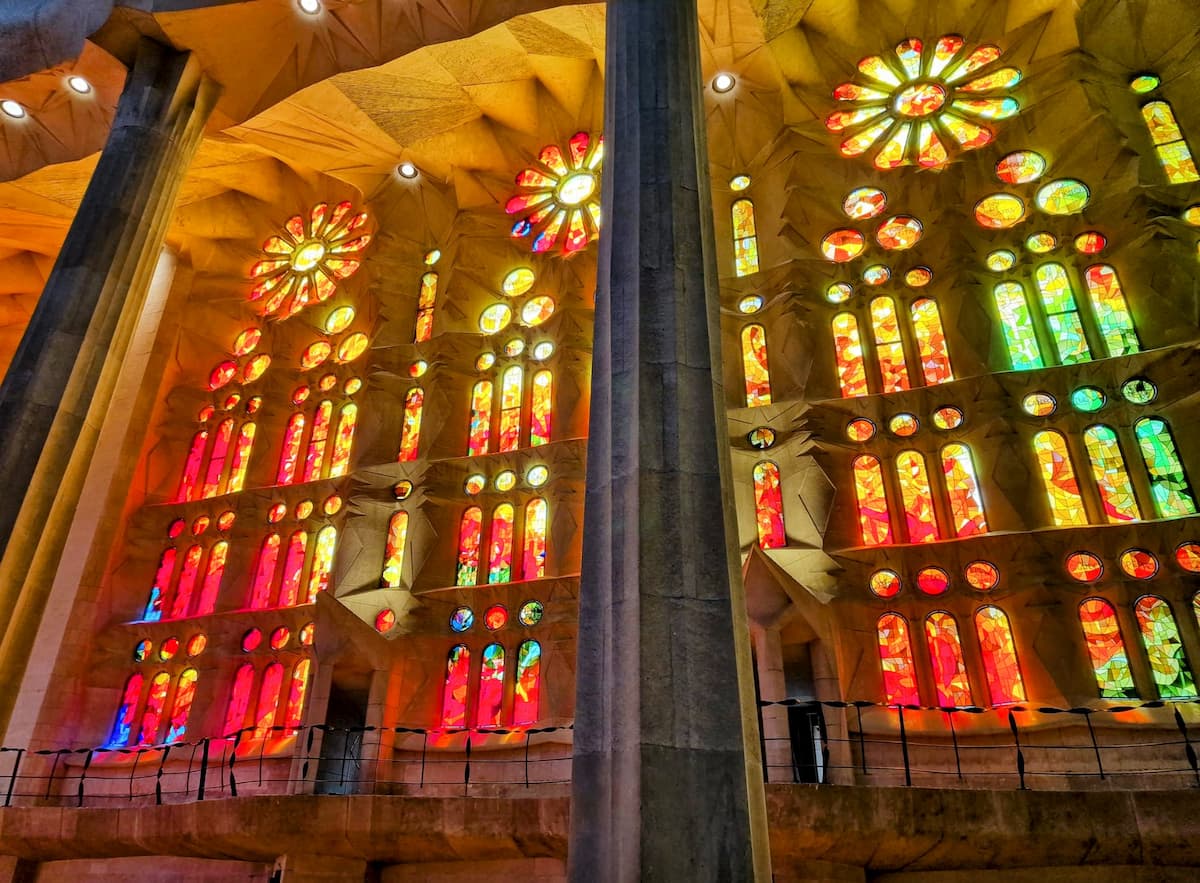
Gaudí’s famous basilica is more than just a symbol of Barcelona – it’s a wonderland of art and architecture, especially on the inside. When you step inside the Sagrada Familia, it’s like entering another world – one filled with vibrant colors, soaring columns, and intricate designs.
I live in Spain and have been to Barcelona many times, and every visit to the Sagrada Familia’s interior still feels like the first – it’s that breathtaking.
So, what exactly can you expect to find inside the Sagrada Familia, and why is it so special? Well, whether it’s those incredible stained glass windows, the sculpted columns that seem to reach the heavens, and all the little details that make this place a masterpiece, get ready to discover why the interior is a must-see for anyone visiting Barcelona.
(Just don’t forget to book your tickets for the Sagrada Familia well in advance. These entry tickets often sell out weeks ahead of time, so you have to secure your spot if you want to go inside.)
Planning a trip to Barcelona last minute?
If you’re booking your trip to Barcelona last minute, I’ve got you covered. Below are some of the top tours, hotels, and more!
⭐ Most popular sights in Barcelona
- Sagrada Familia – tickets often sell out weeks in advance so get your entry ticket here (or entry tickets AND a guided tour here)
- Park Güell – grab your skip-the-line entry
- Casa Batlló – click here for tickets and audio guide
🌍 Top tours in Barcelona
- Montserrat Tour, Monastery and Winery (great day trip!)
- Flamenco Show at Tablao Flamenco Cordobes (incredible night out)
- Tapas Walking Tour with Food, Wine, and History (all the highlights at once)
🛏️ Top hotels in Barcelona
- Ohla Barcelona (5-star luxury with an amazing rooftop pool)
- Seventy Barcelona (boutique hotel with beautiful décor)
- Àmfores Boutique Guest House (great budget option with superb location)
🚌 Want free public transport while you’re in Barcelona? Check out the Hola Barcelona travel card!
Is it worth going inside the Sagrada Familia?
Absolutely, it’s definitely worth going inside the Sagrada Familia. The basilica’s exterior, as incredible as it is, only tells a part of its mesmerizing tale. Stepping inside unveils a world of architectural wonders, artistry, and spiritual depth that photos or descriptions can hardly do justice to.
When you gaze upon the Sagrada Família from the outside, you’re met with an intricate blend of stone, sculptures, and symbolism. But – and I’m not overstating this, promise – the interiors open up a universe of their own.

Antoni Gaudí, the genius behind this masterpiece, meticulously combined nature, theology, and architecture, creating an ambiance that resonates with serenity and awe. The towering columns resembling forest trees, the luminous play of light through the stained glass windows, and the vast, spiraling ceilings all come together in a harmonious symphony, inducing a sense of wonder in every visitor.
Whether you’re an art aficionado, a history buff, or someone seeking a moment of introspection, going inside the Sagrada Familia really does offer a unique experience.
If you only limit yourself to seeing the outside, you’ll truly be missing out on something special. While I understand that many of the tours of Gaudi’s works in Barcelona do only stop to see the façade in the interests of time, I really mean that it’s worthwhile trying to find extra time to see the interior as well (whether you do this as a private tour of the Sagrada Familia or a group one that takes you in).
Want both fast track access to the Sagrada Familia AND a guided tour, to really make sure you don’t miss any of the best things to see? I recommend this guided tour, which gives you exactly that.
What is inside of the Sagrada Familia?
1. Columns
Have you ever found yourself wandering amidst the quiet of a forest, looking up at the towering trees, feeling both humbled and connected? Antoni Gaudí, the mastermind behind Sagrada Família, brought that very sentiment indoors.
Once you step inside, you’re met with columns that don’t simply shoot straight up. Instead, they branch out, much like trees, creating a canopy overhead. This isn’t just design for design’s sake – Gaudí’s intent was to merge nature with sacredness, echoing the organic patterns we see around us.
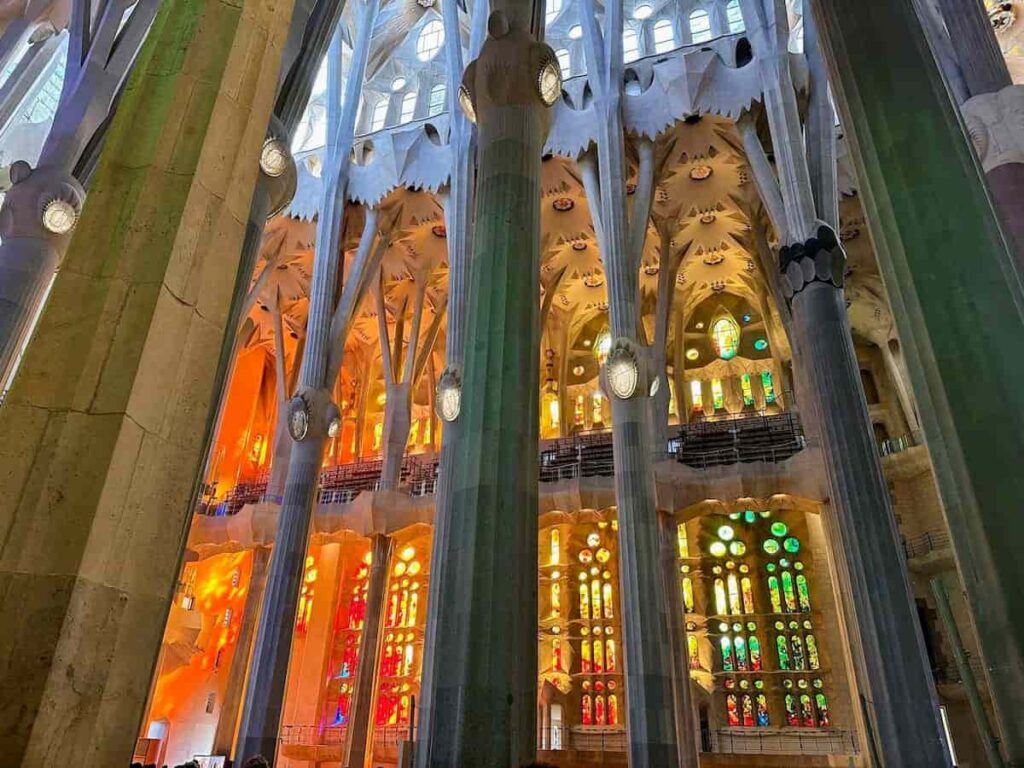
All this means that the columns aren’t just architectural wonders; instead, they symbolize Gaudí’s vision of nature as a cathedral. Each column, with its unique design, represents different tree types, making it a tactile encyclopedia of forest wonders.
2. Stained glass windows
Gaudí, with his keen understanding of light, crafted windows that transition from cooler shades at sunrise to warmer tones at sunset. This isn’t accidental. It’s a carefully orchestrated dance of light meant to evoke different emotions throughout the day.
In fact, for me, this is probably the highlight of the Sagrada Familia’s interior. That is, if you time your visit right, you’ll see the colored light from the windows reflecting off the stone columns, creating an incredible effect like you’re in some kind of fairy woodland.
Beyond their breathtaking beauty, these windows serve as narrators. Each panel, with its blend of colors and patterns, tells tales from sacred texts and legends, making them storytellers, not just windows.
Sitting under their glow, you can’t help but feel enveloped in a cascade of colors, as if the basilica itself is telling you whispered tales from bygone eras.
3. Towers
While the beauty inside the Sagrada Família might leave you spellbound, the towers invite you to take that enchantment to new heights. Symbolizing the Twelve Apostles, the Evangelists, the Virgin Mary, and Christ, these towers are more than just lofty spires – they’re an invitation to see Barcelona from Gaudí’s perspective.
Reaching the summit of either tower opens up panoramic views of the city and beyond. But it’s not just about what you see outside.
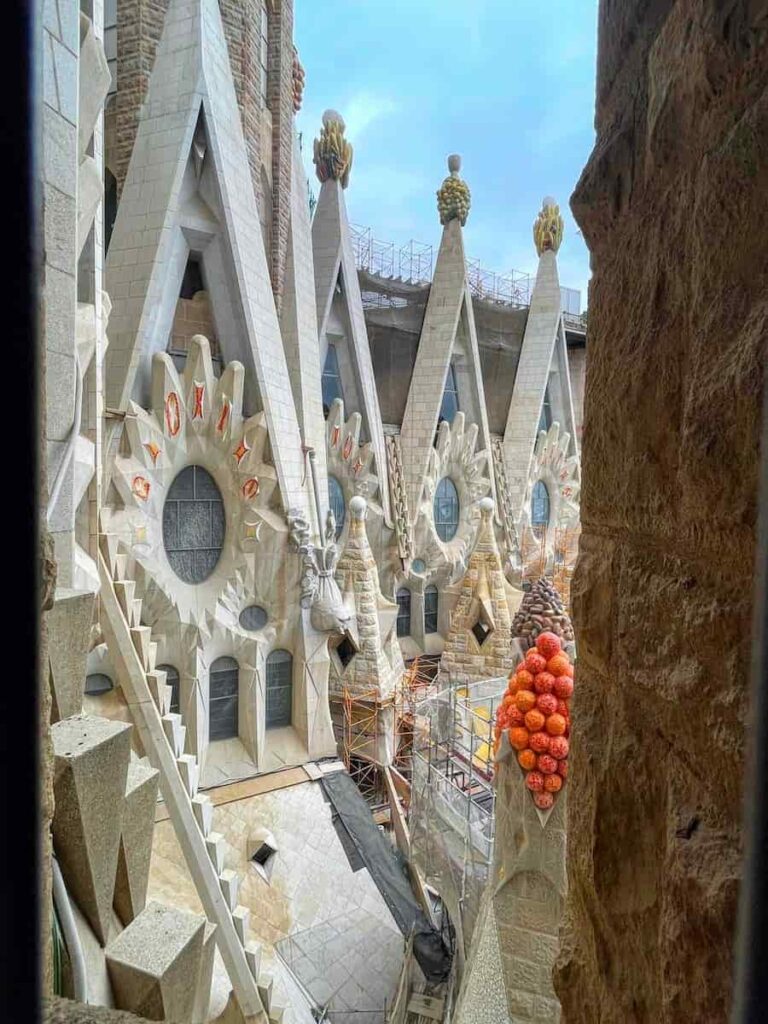
As you step out to the top, you also get a close-up view of the intricate facades, sculptures, and spiral pinnacles that are often missed from the ground. It’s like being let in on an architectural secret.
FYI: If you want to go up one of the Sagrada Familia’s towers, you have to select that option when booking your entry ticket.
There’s the Nativity Tower and the Passion Tower and while both are pretty spectacular, I personally prefer the Passion Tower for sightseeing.
Also keep in mind that places for going up the Sagrada Familia’s towers are very limited given space limitations. If you really want to go up one of them, you need to book your spot well in advance.
4. Gaudí’s tomb
Tucked away within the crypt of the Sagrada Família lies the final resting place of Antoni Gaudí, the visionary architect behind this grand edifice. The tomb, although simple in its design, remains highly significant.
It’s not just the place where Gaudí rests; it symbolizes the culmination of his life’s work and dedication to this monumental project.
As you approach the tomb, there’s a sense of tranquility. A soft light illuminates the space, casting a gentle glow on the tombstone and allowing visitors to pay their respects.
The tomb serves as a poignant reminder of the man whose unparalleled creativity and unwavering faith gave the world one of its most iconic landmarks.
5. Apse
The apse is traditionally the most sacred part of a church, and in the Sagrada Família, it doesn’t disappoint. This semi-circular recess is where the main altar is located, and it serves as the focal point for the liturgical functions of the basilica.
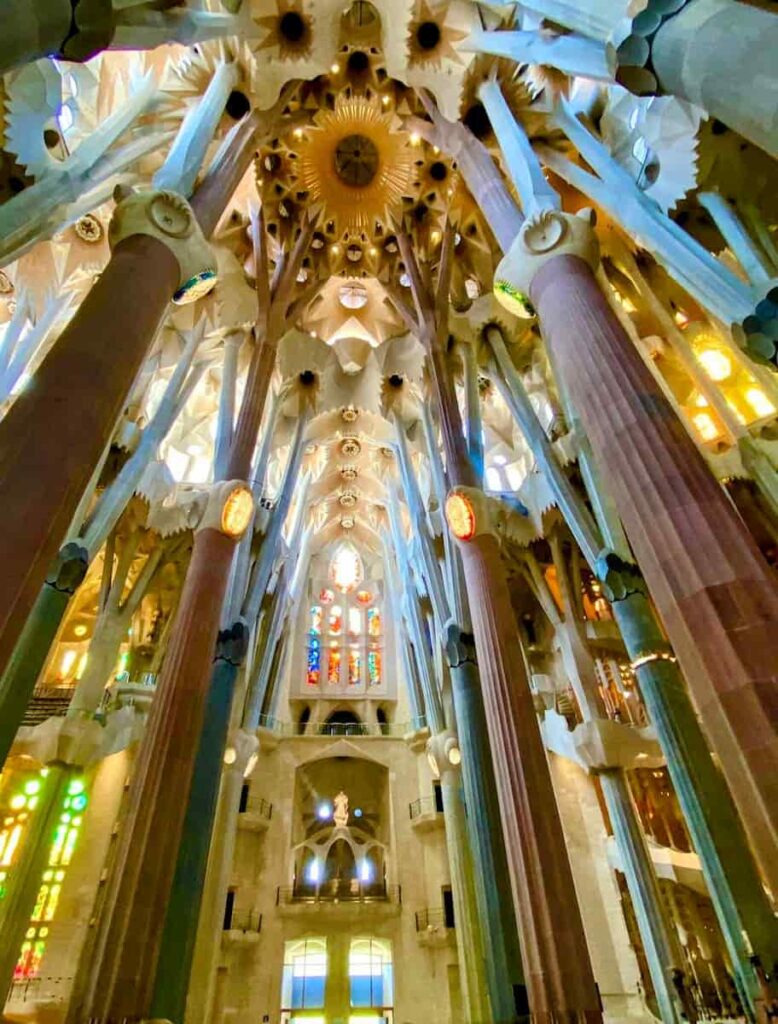
Intricately designed, it reflects the grandeur and devotion that define the entire structure. Basically, with its stunning mosaics, sculptures, and ornate detailing, the apse is a visual masterpiece.
As you look around, you’ll see stories from Christian scriptures, elegantly portrayed through art. Whether you’re religious or simply an admirer of art and architecture, the apse is certainly worth seeing.
6. Cryptogram
One of the many details that showcase Gaudí’s love for intricate designs is the presence of a cryptogram within the Sagrada Família. For those who don’t know, in a cryptogram, any line of numbers – be it vertical, horizontal, or diagonal – sums up to a particular total.
And in the basilica, Gaudí incorporated a cryptogram in the form of a square with 16 numbers.
At first glance, it might seem like a random arrangement. However, the magic lies in the sum of any given four numbers (vertically, horizontally, or diagonally), which always add up to 33, the age at which Jesus is believed to have been crucified.
Gaudí loved embedding deeper meanings and mysteries into his work. Discovering and deciphering details like this adds an element of intrigue to the visit.
7. Anagram
The cryptogram isn’t the only puzzling piece of art inside the Sagrada Familia, as there’s also an anagram shown in multiple spots throughout the basilica.
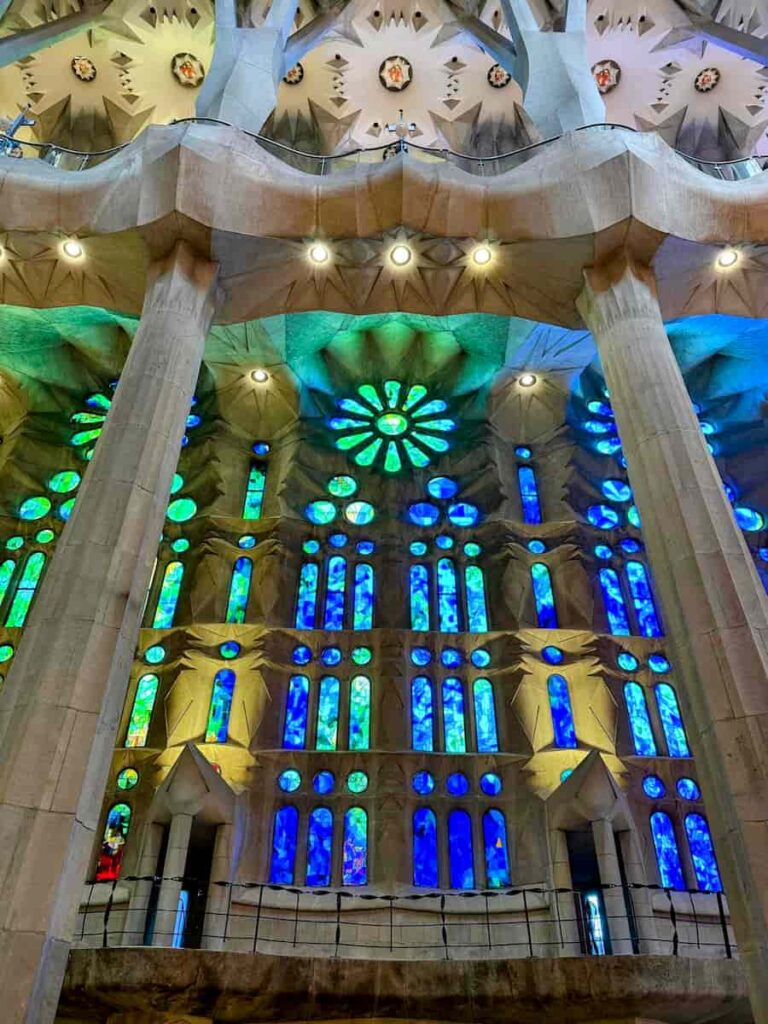
That is, as you wander through the Sagrada Familia, a recurring mosaic “JMJ” may catch your eye. This isn’t just an ornamental feature – it symbolizes Jesus of Nazareth and his parents, Mary and Joseph, epitomizing them as a holy family.
There are some variations of this throughout the building, with one notable example in the Sagrada Familia Museum, but it’s certainly something to keep an eye out for.
8. Organ
The sound of an organ can evoke a range of emotions, from uplifting joy to profound contemplation. In the Sagrada Família, the organ is more than an instrument as, towering with its impressive pipes, it’s both a visual and auditory marvel.
Crafted with precision, it’s been designed to resonate perfectly within the vast interiors, ensuring that every note reaches every corner with clarity and depth. Funnily enough though, it was only installed in 2010, more than 100 years after construction started.
Whether or not you’re religious, you could be lucky enough to time your visit to the Sagrada Familia to be at the same time as a service or an organ recital. If so, you’ll experience an out of this world atmosphere where music melds with the basilica’s architectural beauty.

What’s your perfect destination for your dream trip to Spain?
Want to discover a city or live your island dreams?
Embrace the food scene or step through the pages of history?
Whatever your travel style, discover the perfect Spanish city to add to your trip here!
9. Hanging model
If you’ve ever wondered how Gaudí conceptualized the organic, flowing forms of the Sagrada Família, the answer lies, intriguingly, in an upside-down world. The hanging model is a gravity-assisted representation that Gaudí used to determine the optimal shapes and curves for the church’s design.
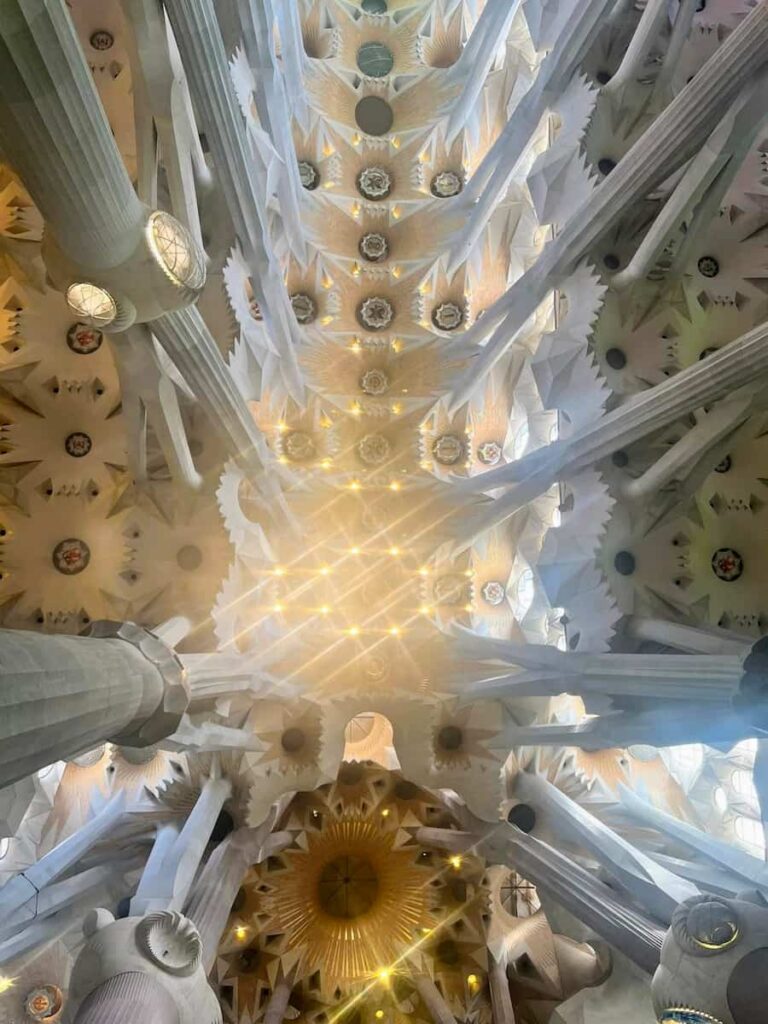
By suspending strings and weights, he could visualize the correct arches and angles necessary for the basilica’s stability. This means that the hanging model is like stepping into Gaudí’s mind, offering a glimpse into his unconventional and pioneering approach to architecture.
It also serves as a tangible example of how he transformed challenges into opportunities for creativity. For those who appreciate the blend of art and science, this model is a fascinating insight into the early stages of the basilica’s conception.
10. Six-toed soldier
One hidden addition to the Sagrada Família is a sculpture of a soldier with six toes. It’s a funny addition to all the grandiosity of the basilica, right on the Nativity façade, which is dedicated to the birth of Jesus.
While the façade is rich with other intricate details and symbols related to Christ’s birth, this tiny anomaly is one that often captures visitors’ imaginations.
Some say that the inclusion of this six-toed soldier was unintentional, a small oversight by the sculptor. Others say that the waiter who served as the model for the sculpture had six toes, so Gaudí chose to keep this in.
Whatever the case, it’s these tiny imperfections and quirks that give the Sagrada Família its charm and relatability. It’s a reminder that even in grand designs and sacred spaces, there’s room for little idiosyncrasies that make stories memorable.
11. The Sagrada Familia Museum
Within the confines of the Sagrada Família is a treasure trove of its history and evolution: The Sagrada Familia Museum. This museum provides visitors with an immersive experience, tracing the journey of the basilica from its inception to its ongoing construction.
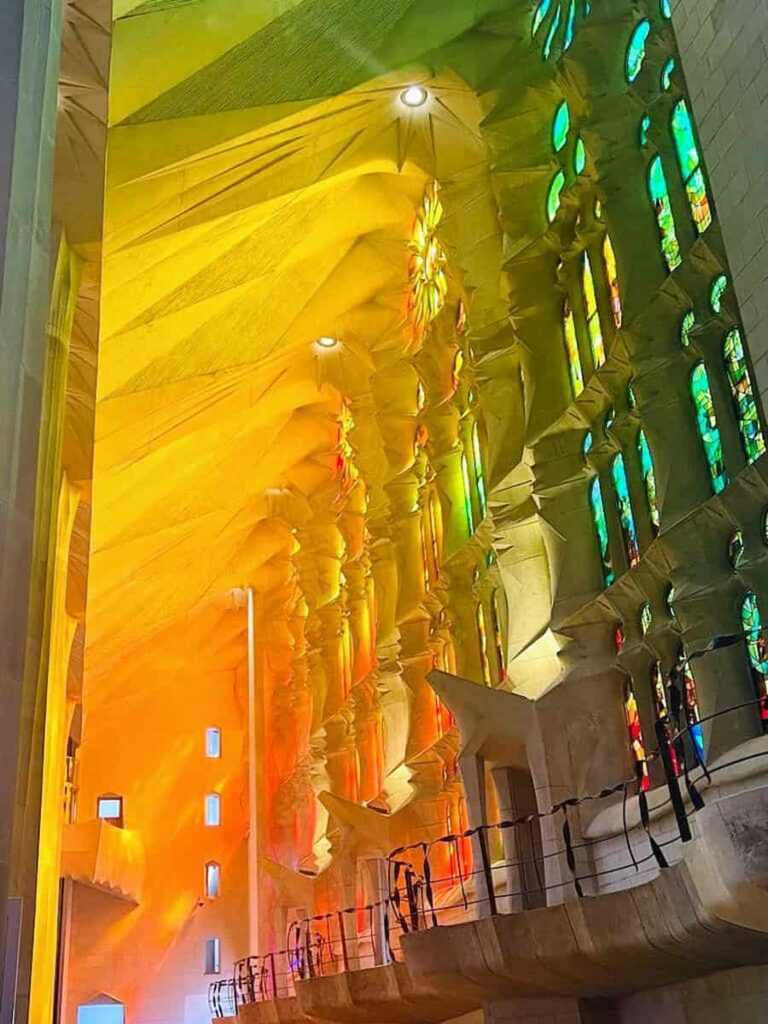
Through sketches, models, photographs, and tools, you’re given a behind-the-scenes look into the making of this architectural masterpiece. And the museum not only chronicles the basilica’s history but also delves into Antoni Gaudí’s life, his inspirations, and his groundbreaking techniques.
It showcases the challenges faced during construction, the evolution of designs, and the fusion of old and new methods that continue to shape the basilica today. It’s a must-visit for anyone keen on understanding the depth of creativity, dedication, and innovation behind the Sagrada Família.
Can you take pictures inside La Sagrada Familia?
Absolutely, you can take pictures inside La Sagrada Familia! Visitors are often left awestruck by the basilica’s interiors and naturally wish to capture its beauty. Photography is allowed, so you can immortalize your memories and the architectural wonders you witness.
However, it’s essential to approach photography with respect. While capturing images, be mindful of the surroundings and the people.
Avoid using flash, especially during services or in areas where it might disturb others. In addition, some specific areas or artifacts might have restrictions, so always look out for signs or ask staff members if you’re unsure.
And remember, while photos are a fantastic way to remember your visit, take a moment to soak in the ambiance, the art, and the serenity that the Sagrada Família offers.
Is there a dress code inside La Sagrada Familia?
Yes, there is a dress code to be observed when visiting La Sagrada Familia. As a place of worship, visitors are expected to dress modestly and respectfully. This means shoulders should be covered, and skirts or shorts should reach down to at least mid-thigh.
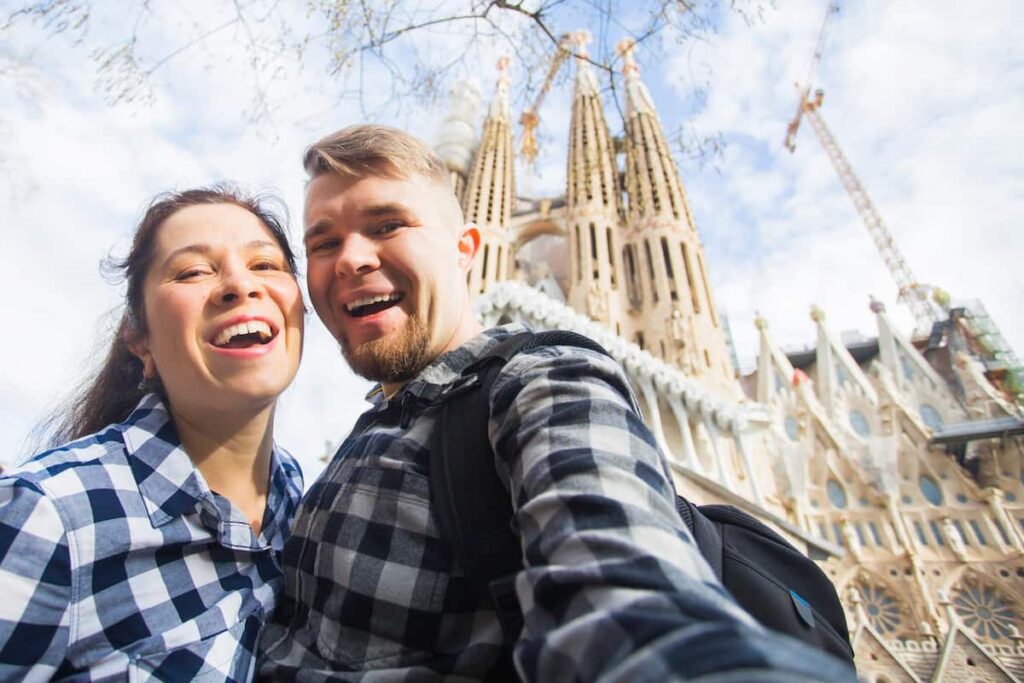
While the Sagrada Família is a major tourist attraction, it’s crucial to remember its primary function as a basilica. That’s why the dress code is strictly applied, meaning visitors are advised to avoid wearing sleeveless tops, plunging necklines, or very short shorts or skirts.
If you happen to be wearing something that might be considered inappropriate, you could bring along a scarf or shawl to drape over your shoulders while inside. Good footwear is also essential, so ensure you’re not wearing flip-flops or going barefoot.
Is the Sagrada Familia hot inside?
No, the temperature inside La Sagrada Familia is relatively moderate and cooler than the outside, especially during the summer months. Its stone construction and high ceilings provide natural insulation, making the interiors pleasantly cool. Large stained glass windows allow sunlight, but they don’t significantly raise the temperature.
The basilica’s design, with its vast spaces and lofty ceilings, facilitates air circulation, ensuring the interiors remain comfortable. While the summers in Barcelona can be quite warm, once you step inside the Sagrada Família, you’ll find it to be a welcome respite from the heat.
However, if you’re visiting during the peak of summer, it’s still a good idea to stay hydrated and carry a bottle of water. The same goes for winter; the basilica can be cooler inside than outside, so you might want to keep a light sweater handy.
Can I bring food inside the Sagrada Familia?
No, visitors are not allowed to bring or consume food inside La Sagrada Familia. It’s a place of worship and reverence, and eating can be disruptive to the atmosphere. The basilica aims to maintain its sanctity and cleanliness, so food and drinks are prohibited.
It’s understandable that touring such an expansive and awe-inspiring structure might build up an appetite. However, it’s best to have your meals or snacks before or after your visit.
There are numerous cafes and restaurants around the basilica where you can relish local or international cuisines. If you’re carrying any food items with you, make sure to store them in your bag during your visit.
Keep in mind that preserving the pristine environment and ensuring a serene experience for all visitors is a collective responsibility, and every small gesture counts.
